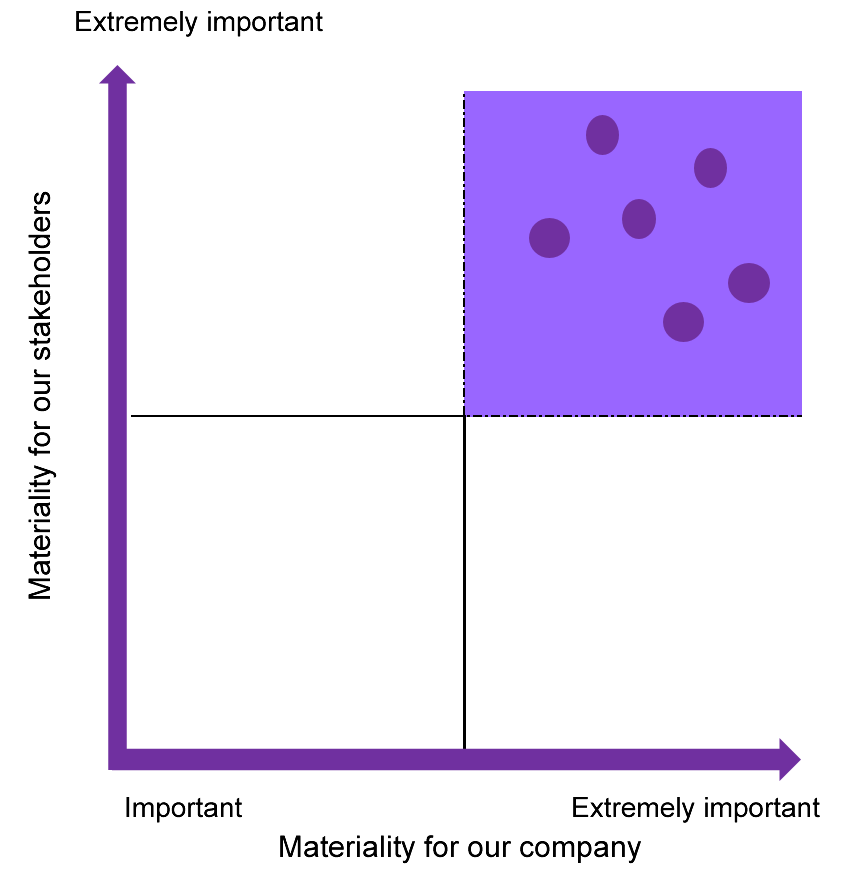Materiality
Identification of materiality (Key issues)
Based on our management philosophy of “contributing to healthcare through the development and sale of leading-edge, superior medical devices,” we have identified six materialities, classified into “materiality in business activities” and “materiality in business infrastructure,” as environmental and social issues that need to be addressed as a priority.
Identification process of materiality
-
【STEP1】Grasp of issues(Listing)
We extensively listed environmental, social, and economic issues, referring to international frameworks and guidelines such as the GRI Standards and SDGs, which are frameworks for ESG information disclosure. In identifying materiality, we considered a wide range of social and environmental changes, regulatory and policy trends, and requests from stakeholders, covering our group’s business domains and supply chains.
-
【STEP2】Extraction and prioritization of materiality(Materiality assessment)
Among the issues listed (221 elements), areas particularly relevant to our business domain were extracted and evaluated for materiality. Materiality analysis was assessed and prioritized on the two axes of “materiality to stakeholders” and “materiality to our company” while integrating issues with high affinity.
-
【STEP3】Validation of materiality
The Sustainability Committee reviewed the evaluation process and the validity of the evaluation results for these materiality candidates. After reviewing the high-priority materiality candidates, we finally identified six materialities. For each identified materiality, we appointed a committee member responsible for developing an action plan, identifying risks and opportunities, and setting long-term targets, KPIs, and target achievement years.

Type Attribute Materiality Business
activitiesS Contribution to medical care Business
infrastructureE Reduction of environmental impact S Initiatives to respect human rights Promotion of diverse human resources
(CMS: Career Management System)G Quality response to medical needs Promotion of corporate governance -
【STEP4】 Identification of materiality
The Sustainability Committee has adopted the identified materiality after deliberation by committee members composed of executive officers. A responsible department in charge reports the progress of the identified materiality initiatives to the Sustainability Committee and continuously works to resolve issues through the PDCA cycle.
Identified materiality
| Type | Attribute | Materiality | Action |
|---|---|---|---|
| Business activities |
S |
Improving patients’ QOL |
Development of products and services that contribute to improving patients’ QOL and enhancement of product procurement capabilities ①Enhancement of development and procurement capabilities ②Conduct seminars and educational training programs |
| Business infrastructure |
E | Reduction of environmental impact | Respond to climate change initiatives (Reduce and disclose GHG emissions) ①Calculation and disclosure of GHG emissions ②Environmental impact reduction activities ③Respond to climate change initiatives |
| S | Initiatives to respect human rights | Respect human rights based on international norms ①Education and seminars on human rights ②Implementation of human rights due diligence |
|
| Promotion of diverse human resources (CMS: Career Management System) |
Diversity & Inclusion ①Disclosure of various systems and data of human resource development ②Creation of an environment where all employees can work productively regardless of their attributes |
||
| Human resources development initiatives ①Execution of various measures for human resources development |
|||
| G | Quality response to medical needs | Stable supply of safe and reliable medical devices ①Quality management initiatives ②Countermeasures for risks of logistics delays caused by climate change |
|
| Promotion of corporate governance | Initiatives for the Corporate Governance Code ①Compliance with the Corporate Governance Code ②Internal Control, Internal Audit |
||
| Initiatives for risk management ①Maintain and follow through on a risk list and practice self-assessment |
|||
| Promotion of compliance management ①Initiatives for the prevention of compliance violations |
Iprogress status
| Type | Attribute | Materiality | Progress results for FYE2024 | Progress results for FYE2025 |
|---|---|---|---|---|
| Business activities |
S | Improving patients’ QOL |
|
|
| Business infrastructure |
E | Reduction of environmental impact |
|
|
| S | Initiatives to respect human rights |
|
|
|
| Promotion of diverse human resources (CMS: Career Management System) |
Utilization rate of systems related to work styles: 92.1% (Note: Percentage of all full-time employees (excluding sales staff) who use any of the systems (time off by the hour, flextime work, telecommuting, combined work, limited area work, etc.)
|
|
||
|
|
|||
|
||||
| G | Quality response to medical needs |
|
|
|
|
|
|||
| Promotion of corporate governance |
|
|
||
|
|
|||
|
|

